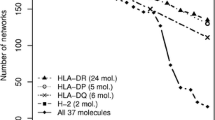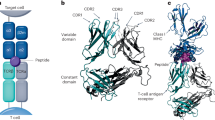Abstract
Major histocompatibility complexes (MHC) play a key role in the immune surveillance system in all jawed vertebrates. MHC class I molecules randomly sample cytosolic peptides from inside the cell, while MHC class II sample exogenous peptides. Both types of peptide:MHC complex are then presented on the cell surface for recognition by αβ T cells (CD8+ and CD4+, respectively). The three-dimensional structure of such complexes can give crucial insights in the presentation and recognition mechanisms. For this reason, softwares like PANDORA have been developed to rapidly and accurately generate peptide:MHC (pMHC) 3D structures. In this chapter, we describe the protocol of PANDORA. PANDORA exploits the structural knowledge on anchor pockets that MHC molecules use to dock peptides. PANDORA provides anchor positions as restraints to guide the modeling process. This allows PANDORA to generate twenty 3D models in just about 5 min. PANDORA is highly customizable, easy to install, supports parallel processing, and is suitable to provide large datasets for deep learning algorithms.
Access this chapter
Tax calculation will be finalised at checkout
Purchases are for personal use only
Similar content being viewed by others
References
He Q, Jiang X, Zhou X, Weng J (2019) Targeting cancers through TCR-peptide/MHC interactions. J Hematol Oncol 12:139. https://doi.org/10.1186/s13045-019-0812-8
Djaoud Z, Parham P (2020) HLAs, TCRs, and KIRs, a triumvirate of human cell-mediated immunity. Annu Rev Biochem 89:717–739. https://doi.org/10.1146/annurev-biochem-011520-102754
Turner SJ, Doherty PC, McCluskey J, Rossjohn J (2006) Structural determinants of T-cell receptor bias in immunity. Nat Rev Immunol 6:883–894. https://doi.org/10.1038/nri1977
Wieczorek M, Abualrous ET, Sticht J et al (2017) Major histocompatibility complex (MHC) class I and MHC class II proteins: conformational plasticity in antigen presentation. Front Immunol 8:292
Kyeong H-H, Choi Y, Kim H-S (2018) GradDock: rapid simulation and tailored ranking functions for peptide-MHC Class I docking. Bioinformatics 34:469–476. https://doi.org/10.1093/bioinformatics/btx589
Abella J, Antunes D, Clementi C, Kavraki L (2019) APE-gen: a fast method for generating ensembles of bound peptide-MHC conformations. Molecules 24:881. https://doi.org/10.3390/molecules24050881
Menegatti Rigo M, Amaral Antunes D, Vaz de Freitas M et al (2015) DockTope: a web-based tool for automated pMHC-I modelling. Sci Rep 5:18413. https://doi.org/10.1038/srep18413
Fagerberg T, Cerottini J-C, Michielin O (2006) Structural prediction of peptides bound to MHC class I. J Mol Biol 356:521–546. https://doi.org/10.1016/j.jmb.2005.11.059
Marzella DF, Parizi FM, van Tilborg D et al (2022) PANDORA: a fast, anchor-restrained modelling protocol for peptide: MHC complexes. Front Immunol 13:878762
Webb B, Sali A (2017) Protein structure modeling with MODELLER. In: Kaufmann M, Klinger C, Savelsbergh A (eds) Functional genomics: methods and protocols. Springer, New York, pp 39–54
Soteras Gutiérrez I, Lin F-Y, Vanommeslaeghe K et al (2016) Parametrization of halogen bonds in the CHARMM general force field: improved treatment of ligand–protein interactions. Bioorg Med Chem 24:4812–4825. https://doi.org/10.1016/j.bmc.2016.06.034
Berman HM (2000) The protein data bank. Nucleic Acids Res 28:235–242. https://doi.org/10.1093/nar/28.1.235
Muñoz V, Serrano L (1997) Development of the multiple sequence approximation within the AGADIR model of α-helix formation: comparison with Zimm-Bragg and Lifson-Roig formalisms. Biopolymers 41:495–509. https://doi.org/10.1002/(SICI)1097-0282(19970415)41:5<495::AID-BIP2>3.0.CO;2-H
Shen Y, Maupetit J, Derreumaux P, Tufféry P (2014) Improved PEP-FOLD approach for peptide and miniprotein structure prediction. J Chem Theory Comput 10:4745–4758. https://doi.org/10.1021/ct500592m
Edgar RC (2004) MUSCLE: multiple sequence alignment with high accuracy and high throughput. Nucleic Acids Res 32:1792–1797. https://doi.org/10.1093/nar/gkh340
Heterogeneous parallelization and acceleration of molecular dynamics simulations in GROMACS. J Chem Phys 153(13). https://aip.scitation.org/doi/10.1063/5.0018516. Accessed 31 Oct 2022
Reynisson B, Alvarez B, Paul S et al (2020) NetMHCpan-4.1 and NetMHCIIpan-4.0: improved predictions of MHC antigen presentation by concurrent motif deconvolution and integration of MS MHC eluted ligand data. Nucleic Acids Res 48:W449–W454. https://doi.org/10.1093/nar/gkaa379
Acknowledgments
This project is supported by the Hypatia Fellowship from Radboudumc (Rv819.52706) and Open eScience grant from the Netherlands eScience Center (NLESC.OEC.2021.008). FP acknowledges a visiting scholarship from the Department of Scholarships and Students’ Affairs Abroad, Ministry of Science, Research and Technology, Iran.
The authors sincerely thank Gayatri Ramakrishnan, Max Luppes, Coos Baakman, Heleen Severin, and Nicolas Renaud for suggestions and proofreading.
Author information
Authors and Affiliations
Corresponding author
Editor information
Editors and Affiliations
Rights and permissions
Copyright information
© 2023 The Author(s), under exclusive license to Springer Science+Business Media, LLC, part of Springer Nature
About this protocol
Cite this protocol
Marzella, D.F., Crocioni, G., Parizi, F.M., Xue, L.C. (2023). The PANDORA Software for Anchor-Restrained Peptide:MHC Modeling. In: Reche, P.A. (eds) Computational Vaccine Design. Methods in Molecular Biology, vol 2673. Humana, New York, NY. https://doi.org/10.1007/978-1-0716-3239-0_18
Download citation
DOI: https://doi.org/10.1007/978-1-0716-3239-0_18
Published:
Publisher Name: Humana, New York, NY
Print ISBN: 978-1-0716-3238-3
Online ISBN: 978-1-0716-3239-0
eBook Packages: Springer Protocols




